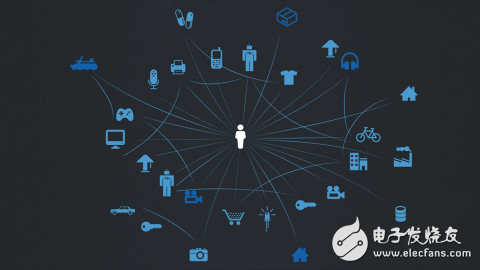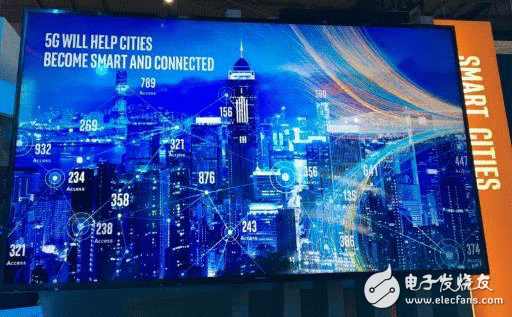The World Mobile Communications Conference (MWC2017), which leads the future of the global mobile communications industry, is being held in Barcelona. The focus of this MWC is undoubtedly the 5G that will formally determine the standard. The 5G progress and its application in major industries is a must-see for this conference.
What wonderful new experiences can 5G bring? In the hottest virtual reality (VR), the limitation of transmission technology is that the current VR devices have to endure wired connections, poor graphics and weak performance. The solution that can be seen now is to use 5G. High-speed transmission, wide-area coverage, and the ability to get through the cloud for a more immersive and intelligent experience. Of course, VR is only one of the technologies that benefit from the development of 5G. The real best match for 5G and the win-win situation will be the much-watched Internet of Things. This is also the combination of Intel's future-oriented combination.

5G is the next generation connection technology for the Internet of Things
The Internet of Things is one of the greatest dreams of mankind. The realization of this dream requires the support of many technologies, and 5G is an indispensable part of it. For the Internet of Things, its main application scenarios are smart industry, intelligent agriculture, intelligent transportation, smart grid, smart home, smart city, car networking, etc., so the basic demand for machine-type communication for 5G networks is concentrated in massive terminal access, Ultra-low latency, efficient connection, low cost, low power consumption, high reliability, and full geographical coverage. The most important points in the connection technology requirements of IoT applications are: low power consumption to ensure long-lasting, high-speed, intelligent applications with higher performance, low latency to ensure near real-time data transmission, high connectivity Density to ensure that huge terminal devices can access the network at any time.
5G key performance indicators include user experience rate, connection density, end-to-end delay, traffic density, mobility, and user peak rate. 5G needs to have higher data transmission performance than 4G, support user experience rate up to 1Gbps; millisecond end-to-end delay; million-level connection density per square kilometer, and tens of Tbps per square kilometer Density, mobility above 500Km per hour and peak rate of tens of Gbps. Among them, the user experience rate, delay and connection density are the three basic performance indicators of 5G. These three performance indicators are not so much for smartphone users, but rather for the technical requirements tailored for the Internet of Things.
eMBB (large-traffic mobile broadband services such as 3D or ultra-high-definition video), mMTC (large-scale Internet of Things services) and URLLC (such as unmanned driving, industrial automation, etc., which require low latency and high reliability connection) are 3G defined by 3GPP Big scene. Unmanned driving and industrial automation are the Internet of Things in the general sense. Therefore, 5G is the wide-area wireless connection technology that the Internet of Things has been waiting for.

Figure: Most IoT smart devices are not in the home or mobile phone, but in the factories, businesses, and medical fields.
Intel seizes 5G opportunities
Intel is a pioneer and leader in 5G technology development. In the face of huge market demand, Intel has integrated its products and architecture into every segment of the “cloud to the material†landscape, providing devices, networks and the cloud. 5G end-to-end solution and accelerate the deployment of 5G networks with equipment manufacturers, telecom operators, service providers, industry leaders in 5G applications, standards development organizations and many other partners.
We can count Intel's many leading actions in 5G: release the industry's first global 5G modem, launch the first unmanned Intel GO smart driving 5G vehicle communication platform, and take the lead in deploying stable and mature partners. The 28GHz millimeter-wave RF architecture is the first company to launch a 5G mobile test platform and the only chip company to receive the IMT-2020 (5G) promotion group certificate in the first phase of China's 5G technology R&D trial.
At this year's MWC, Intel demonstrated a number of new results for 5G, including the first Gigabit LTE modem - Intel XMM7560, third-generation Intel 5G mobile test platform and numerous network edge and storage products, and no one The four application areas of driving, smart city, smart home and virtual reality showcase the innovative connectivity experience that Intel and partners have developed together. Intel is constantly providing leading connectivity technologies and solutions, and working with a wide range of industry leaders to accelerate the advent of the 5G era and lay a solid foundation for the boom in the Internet of Things.

Figure: Intel booth at MWC 2017
Intel makes 5G and the future of the Internet of Things full of imagination
Intel's 5G strategy is not independent, it is inseparable from Intel's Internet of Things strategy. Over the past few years, Intel has been emphasizing the strategic goal of fully evolving into the Internet of Things. The IoT contains all the smart devices connected to the cloud. Its technological innovation is end-to-end, including computing, communications + storage, software, reliability + analysis, etc. . From things to the cloud, Intel has unique end-to-end advantages: general-purpose chips, FPGAs, 5G, data centers, etc. Intel is breaking the technical bottleneck of the Internet of Things with a wide range of technologies and product portfolios.
Breakthrough technologies in the fields of virtual reality, artificial intelligence, and the Internet of Things have placed unprecedented demands on wireless networks. Only 5G networks can meet the speed, latency and energy efficiency requirements of the Internet of Things. At MWC2017, Intel is fully promoting the win-win of the Internet of Things and 5G, demonstrating relevant solutions and application scenarios for smart cities and smart homes.

Figure: In Intel's view, 5G will help the city's smart Internet
In smart cities, Intel believes that big data and next-generation connectivity technologies can reshape urban landscapes and reduce the pressure on natural resources and infrastructure. From using millions of sensors to monitor air and water quality, to smart lighting, to traffic control, etc., 5G will give us the insight we need to improve the quality of life for everyone. To this end, Intel exhibited Bosch Air Quality Monitoring, City Beacon, GE Connected Light Pole, Connected UAVs for First Aid, and demonstrations using NB-IOT Monitoring Pumps at MWC.

Figure: Demo using the NB-IOT monitoring pump
Compared to the intelligent urban family, Intel also brings several innovative demonstrations on MWC in each person's small space, such as home millimeter wave fixed mobile broadband, through Intel Gateway Solution (GRX750) and Intel Range Extender technology. Cases such as seamless indoor coverage and intelligent home integrated voice control functions. In Intel's view, 5G will create the era of smart home through the virtualized core infrastructure of Gigabit broadband and the fast, seamless and secure home network; in addition, 5G-based smart home will enrich daily life, simplify household chores and bring Come to high reliability.
Through an optimized and efficient network infrastructure, Intel's advancements in areas such as 5G network connectivity and NR solutions enable interoperable smart home devices to quickly and reliably connect to content and services stored in edge clouds and on local wireless networks. Switch between to achieve uninterrupted home security and automation, and support reliable home health care and high quality video entertainment services. At MWC2017, Intel announced a partnership with leading home appliance provider Humax to launch a new router with Intel technology and McAfee security home platform. This router is an important step in the foundation of the future 5G smart home.

Figure: In Intel's view, 5G will create a smarter home that is more comfortable and easy to manage.
To better serve smart cities and smart home applications, Intel has built the LTE IoT Rapid Deployment Project (Intel LIQD). Through this LTE IoT Rapid Deployment project, Intel announced a new commercial device based on LTE that can be deployed immediately, and will work with AT&T to promote certified IoT devices to be more quickly listed and networked to meet the projected global reach of 2020. The demand for 50 billion connected devices. Through pre-integration of platform components and pre-certification of network services, the Intel LIQD project will enable companies of all sizes to deploy and manage a range of configurable sensor devices in weeks rather than months. This IoT platform is a cloud management service that plays a vital role in supporting IoT business applications. The project enables operators and equipment manufacturers to better coordinate equipment and services to provide a simple cloud-ready solution to support future 5G systems.
In addition, Intel has teamed up with China Mobile and Ericsson to conduct an interconnected factory trial at a radio manufacturing facility in Nanjing, bringing the world's first interconnected plant based on the Industry 4.0 Cellular Internet of Things (NB-IOT). The plant is currently implementing several low-power wide-area (LPWA) use case tests such as line monitoring, warehouse monitoring, and packaging and material tracking. The interconnected high-precision screwdriver shown at MWC2017 is equipped with a motion sensor and is connected to the NB-IOT module to transmit the collected data information to the cellular network. The Interconnected Screwdriver Demo is an end-to-end solution that covers everything from endpoints to networks to platforms and data analytics. The test is based on Ericsson's multimode base station equipped with technologies such as NB-IOT, Intel's Intel® XMMTM 7115 modem solution supporting technologies such as NB-IOT, and Fibocom module based on the solution, as well as China Mobile's OneNet IOT platform and Its Software Development Kit (SDK)
Canaan is a leading provider of supercomputing solutions, distinguished for superior cost-efficiencies and performance. In addressing the limitations of today`s computing hardware, Canaan strives to advance the world we live in by powering transformative technologies.
Canaan is renowned for having invented the world`s first ASIC-powered Bitcoin Mining Machine in 2013, radically catalysing the growth of a computationally-advanced bitcoin mining sector.
Developed through academic research, rigorous expertise in semiconductor design, and backed by a robust network of strategic partners, Canaan continues to expand its suite of advanced hardware offerings, exploring opportunities across some of the world`s most exciting emerging technologies.
Canaan AvalonMiner:Canaan AvalonMiner 821,Canaan AvalonMiner 841,Canaan AvalonMiner 741,Canaan AvalonMiner 1246,Canaan AvalonMiner 921,Canaan AvalonMiner 1166 Pro
Canaan Avalonminer,1166 Pro 66T,Avalon 821,Avalon 1246,avalon miner
Shenzhen YLHM Technology Co., Ltd. , https://www.apgelectrical.com